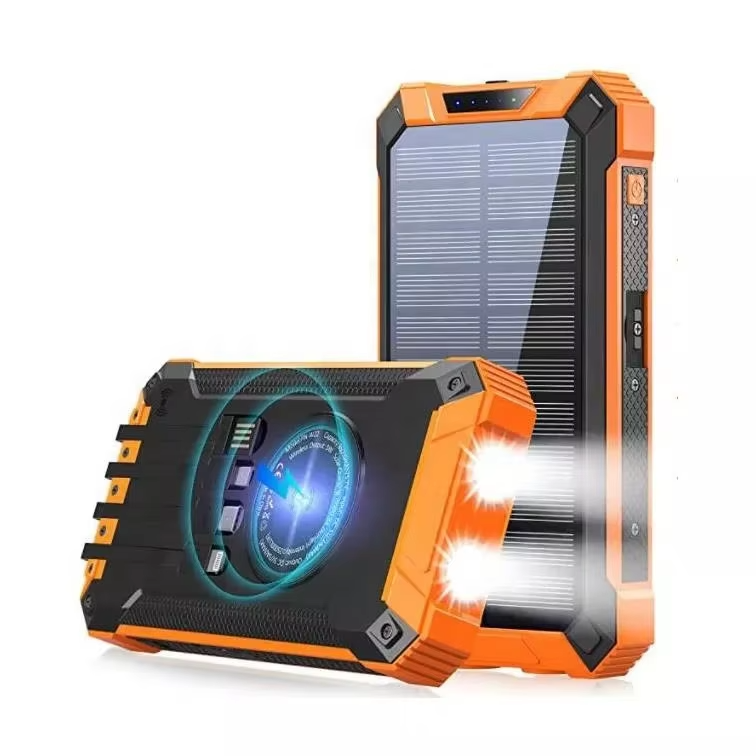In today’s world, where smartphones, tablets, and other portable devices are integral to our daily lives, keeping them charged while on the go has never been more important. Whether you’re hiking through the wilderness, camping in a remote area, or just looking for an eco-friendly backup for emergencies, a solar power bank could be the solution. It offer the convenience of charging via sunlight, which sounds great in theory, but are they truly worth to have?
In this blog, we’ll explore everything you need to know about solar power banks, including how they work, the advantages and limitations, and when it’s worth purchasing one. By the end, you’ll have all the information needed to make an informed decision.
Table of Contents:
- How Do Solar Power Banks Work?
- Advantages of Solar Power Banks
- Limitations and Disadvantages of Solar Power Banks
- Real-World Experiences and Personal Insight
- When Is a Solar Power Bank Worth Buying?
- Alternative Solutions to Solar Power Banks
- Conclusion
How Do Solar Power Banks Work?
Solar power banks are portable charging devices that come with built-in solar panels. These panels convert sunlight into electrical energy, which is then stored in an internal battery. Once charged, the stored energy can be used to power or charge various devices, such as smartphones, tablets, or even small electronics. The process is straightforward:
- Sunlight Absorption: The solar panel captures sunlight.
- Energy Storage: The captured energy is converted into electrical energy and stored in the internal battery.
- Device Charging: The stored energy is used to charge your devices.
Solar power banks are typically equipped with USB ports, and some feature wireless charging capabilities, such as solar wireless phone chargers. There are also models that support qi solar power banks for devices that support wireless charging. While solar charging is a convenient, environmentally friendly option, it is not as efficient or fast as traditional USB charging, which means it might not always be practical for daily use.
Advantages of Solar Power Banks
There are several reasons why solar power banks are gaining popularity, particularly among outdoor enthusiasts and those who value eco-friendly products. Let’s take a look at the key benefits:
- Eco-friendliness: Solar power banks use renewable energy, reducing reliance on fossil fuels. They help minimize your carbon footprint, making them an attractive option for eco-conscious users.
- Ideal for Outdoor Adventures: Whether you’re camping, hiking, or traveling off the beaten path, a solar power bank offers a way to charge your devices without the need for electrical outlets. If you’re on a long trip and need a solar battery charger for rechargeable batteries, a solar power bank can be a lifesaver.
- Emergency Backup Power: Solar power banks can be extremely valuable during power outages or in emergency situations. The built-in solar charger flashlight provides an extra layer of functionality, offering light when needed.
- Portability and Convenience: Solar power banks are compact, lightweight, and easy to carry, making them perfect for travel. Many come with a qi solar power bank feature, allowing wireless charging for a hassle-free experience.
Limitations and Disadvantages of Solar Power Banks
Despite their many advantages, solar power banks come with certain limitations that might affect their appeal to some users.
1. Slow Charging Speed
One of the biggest drawbacks of solar power banks is their slow charging speed. Solar charging is significantly slower than charging through a wall outlet. For example:
- A 10,000mAh solar power bank can be charged in about 4-5 hours through a standard outlet, but in the sun, it could take up to 50 hours for a full charge. At best, you can expect it to charge about 200mAh per hour directly in the sun.
- A 5000mAh solar power bank may take 20-30 hours to charge fully via solar energy, while a 10,000mAh solar power bank could take 45-50 hours.
This slow charging makes solar power banks unsuitable for those who need quick, reliable charging. They are best used as a backup power source in situations where quick charging is not crucial.
2. Weather Dependency
The efficiency of solar panels relies on weather conditions. Overcast or rainy days significantly reduce the charging speed or prevent the panels from working effectively. If you live in an area with frequent cloudy weather, a solar power bank may not be a reliable option for everyday charging.
3. Limited Battery Capacity
Most solar power banks offer capacities ranging from 5,000 to 20,000mAh. While this is sufficient for light usage, it may not meet the needs of heavy device users who require continuous charging throughout the day. For instance, if you’re on a long trip and need to keep multiple devices charged, a solar power bank may fall short.
4. Higher Initial Cost
The price of a solar power bank is generally higher than that of a regular power bank due to the added solar technology. While this makes it a good investment for specific use cases, the initial cost may not be justified for users who need a fast and reliable charging solution.
Review From Blavor and Personal Experience
Positive User Experiences
Many users who enjoy outdoor activities like camping, hiking, or backpacking find solar power banks to be an invaluable tool. The ability to charge devices using sunlight, especially when electricity is unavailable, is a game-changer. The solar charger flashlight feature is another advantage, providing light in the dark without the need for disposable batteries.
Negative User Experiences
On the other hand, some users express frustration with the slow charging times, especially in conditions with less sunlight. Users relying solely on solar charging have reported that it can take days to fully charge the device, which can be impractical in urgent situations. Additionally, some consumers have had trouble with solar efficiency during cloudy weather, reducing the effectiveness of the device.
My Advice
From personal experience, I prefer using a traditional fast-charge power bank for everyday, indoor use because of its speed and reliability. However, for outdoor adventures like hiking or camping, a 20,000mAh solar power bank is a better choice. The larger capacity ensures I have enough power for multiple charges, and the ability to recharge the power bank through solar energy while off the grid is incredibly valuable.

When Is a Solar Power Bank Worth Buying?
A solar power bank is worth purchasing if:
- You frequently go hiking, camping, or on long road trips where access to electricity is limited.
- You live in an area with frequent power outages and need a reliable backup power source.
- You are environmentally conscious and want to reduce your reliance on traditional electricity.
However, if you need fast, efficient charging for daily use, a solar power bank may not be the best option. Traditional power banks offer faster and more reliable charging for everyday use.
Alternative Solutions to Solar Power Banks
If solar power banks are not the right fit for your needs, there are several alternative solutions:
- Traditional Power Banks: For fast charging and everyday use, a traditional power bank is more efficient and reliable. They charge devices quickly and are perfect for daily use.
- Portable Solar Panels: If you need to charge multiple devices or require faster solar charging, a portable solar panel may be a better solution. These panels are larger and more efficient than those integrated into power banks.
- Solar Power Stations: For longer trips or more intensive power needs, solar power stations are a great choice. They integrate solar panels with larger batteries and can charge multiple devices simultaneously.

Finally
Solar power banks are an excellent option for outdoor enthusiasts, eco-conscious individuals, and emergency preparedness. They provide a sustainable way to keep your devices charged when electricity isn’t available. However, they come with limitations, particularly in terms of charging speed and weather dependency.
For regular daily use, traditional power banks may be a better choice due to their efficiency. But if you often find yourself in off-grid situations or need an emergency backup, a solar power bank could be a valuable investment.
Last, If you’re ready to make the switch to solar, explore the best solar power banks available and find one that suits your needs. Whether you’re hiking in the wilderness or simply looking for a more sustainable charging option, a solar power bank can provide the peace of mind you need.



